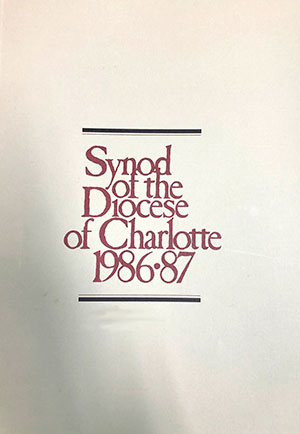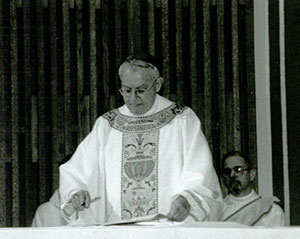 CHARLOTTE — In 1987 the Diocese of Charlotte’s second bishop, Bishop John F. Donoghue, gathered lay men and women, religious and clergy from across the diocese for a synod to address issues facing the growing Church in this missionary territory. It was the first synod in the diocese’s history, and its impacts continue to be seen 35 years later.
CHARLOTTE — In 1987 the Diocese of Charlotte’s second bishop, Bishop John F. Donoghue, gathered lay men and women, religious and clergy from across the diocese for a synod to address issues facing the growing Church in this missionary territory. It was the first synod in the diocese’s history, and its impacts continue to be seen 35 years later.
What is a synod?
By definition, a synod is an assembly of ecclesiastics or other Church delegates gathered pursuant to the law of the Church for the discussion and decision of ecclesiastical affairs; an ecclesiastical council.
Why hold a synod?
In his letter to the people of the diocese on Sept. 14, 1985, Bishop Donoghue said, “It is my hope that in the broad consultation called for by a Synod, we will be able to develop a pastoral plan which will shape the diocese for the future so that together, we will be the ‘sign and instrument of communion with God and unity among all men.’” (Vatican II, “Constitution of the Church”)
When did the synod take place?
From October 1985 until the first meeting of the synod in September 1986, Bishop Donoghue established preparatory commissions, held parish programs during Lent to address the issues to be discussed, selected members to attend, and created materials to be considered at the synod.
After the first meeting of the synod in September 1986, the preparatory commission revised the materials. The second session of the synod was held in January 1987. The materials were then revised a second time. The final session of the synod was held in May 1987. The synod documents were promulgated, or published, at that time, and the implementation of the diocesan pastoral plan established by the synod then began.
In all, more than 140 people from around the diocese contributed their time and talents to the synod.
In his letter of promulgation on May 23, 1987, Bishop Donoghue noted, “Through this Synod, we have grown together as a community of faith. We have supported one another as a community of love; and we have served one another and our brothers and sisters throughout the Diocese of Charlotte, out of a conviction of faith and an experience of God’s Spirit at work within us.
“The sole task of this Synod has been to glorify the Lord through the advancing of His Kingdom in this Diocese, at this time, through the men and women who are now providentially the People of God of the Diocese of Charlotte. I am confident that what we propose for implementation will lead each of us and all members of the Church of Charlotte to be mindful of the need for personal and ecclesial purification and the need to reach out and truly be a ‘light to the nations.’”
What was the synod’s outcome?
 On May 23, 1987 at St. Patrick Cathedral in Charlotte, Bishop John Donoghue promulgates documents coming out of a two-year diocesan synod addressing the issues facing the growing Church in western North Carolina. (Diocese of Charlotte Archives) Seven areas were addressed during the synod that saw direct results afterward: spiritual life, evangelization, education, poverty, lay ministry, councils and growth.
On May 23, 1987 at St. Patrick Cathedral in Charlotte, Bishop John Donoghue promulgates documents coming out of a two-year diocesan synod addressing the issues facing the growing Church in western North Carolina. (Diocese of Charlotte Archives) Seven areas were addressed during the synod that saw direct results afterward: spiritual life, evangelization, education, poverty, lay ministry, councils and growth.
Monsignor John J. McSweeney, the first priest ordained for the Diocese of Charlotte and retired pastor of St. Matthew Church in south Charlotte, was vicar general and chancellor of the diocese during the time of the synod.
Monsignor McSweeney stresses that those seven areas were carefully selected, and great effort went into selecting Catholics from around the diocese to participate in the synod and discuss these topics.
“At that time we had no idea of the growth the diocese would experience,” he noted. “We made sure we kept it balanced, as there are 46 counties in the diocese.
We didn’t want everything based or centered in Charlotte.”
Monsignor McSweeney believes the 1987 Synod is historically significant for many reasons, which can be seen in the fruits of the synod still tangible today. In particular, he has witnessed a great impact in the areas of Catholic schools, lay ministry, Catholic Charities and the work of pastoral councils in the local parishes.
“At the time of the synod, there was a bold effort to save Catholic schools, to make sure there was equity in pay (for teachers), to build Catholic identity, merge schools and build new ones,” he said.
Thanks to the synod, every parish in the diocese has a range of ministries for people to participate in, according to the seven topics the synod focused on.
Thinking back to the time of the synod, Monsignor McSweeney said, “What amazed me so much was all these people giving their time – seriously giving their time.”
— SueAnn Howell, Senior reporter


